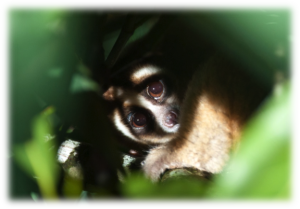By Louisa Musing
MSc Primate Conservation student 2013-2014
It was their eyes, those large, captivating eyes that first caught my attention.
© Andrew Walmsley

The slow loris is a beautiful yet vulnerable primate. Its’ elegant, snake-like movement through the trees, mysterious nature, and unique morphology fascinated me even in the pictures, however it was their continued and often illegal exploitation that drove me to conduct research into one of their most pertinent threats.
In collaboration with Little Fireface Project (LFP) and Japan Wildlife Conservation Society (JWCS) I investigated into the previously under-studied Japanese slow loris pet trade; the magnitude of their exploitation, the legitimacy of their sale, and their care and treatment when kept as pets. I conducted: in-store and online pet shop investigations, informal interviews with pet shop owners, analysis of trade and confiscation records, and examined the conditions slow lorises are subjected to in private households through Japanese online videos. Whilst planning the details of my research in Tokyo, people kept asking me how I would react to seeing slow lorises being sold as pets, a trade which is widely recognised as violating species welfare. The answer was always the same; I knew it would be hard, but I was an animal lover through and through. I needed to help, do something useful, and be a part of protecting these creatures and their future.
Japan is renowned for its fascination with exotic wildlife and is one of the largest wildlife consumers in the world. The country has been internationally criticised for its poorly regulated wildlife law enforcement, weak penalties imposed upon law breakers, and involvement in illegal trade activities. Despite slow lorises’ internationally protected status, venomous bite, and complex captive care requirements my research confirmed their high demand as pets in Japan with 74 slow lorises observed on sale in just a two week period, and uncovered clear evidence of illegal trade through falsified permits and smuggling. I verified that the current penalties for illegal activities are weak, law enforcement is poorly regulated, and border control staff’s knowledge on species is limited. My research further authenticated the unsuitability of slow lorises as pets. Online videos revealed slow lorises frequently in human contact, overweight, and wounded. They were observed consuming foods that disregarded their natural feeding patterns, were housed in bright lighting and unnatural conditions, and were continuously seen exhibiting stress behaviours. My findings also reiterate how the general public are misinformed regarding species welfare, and are unable to comprehend the necessary requirements slow lorises need for a good standard of living. I can only emphasise the need for more stringent legislation at Japanese borders, regular monitoring of the pet trade, increased education for border control staff, particularly regarding species identification, and raising public awareness on their ecological importance in the wild and their unsuitability in private households.
Whilst these research aspects were integral to my project, I also took time to present a lecture on slow loris behaviour, ecology, conservation and protection, in Tokyo, in collaboration with JWCS, to students, professionals, conservationists, and zoo staff. We received very positive feedback and were encouraged to keep educating the Japanese public about the slow loris in an attempt to reduce demand. Finally, with the help of Professor Anna Nekaris, a new slow loris species identification guide was developed with details on all 8 species in English and Japanese to aid conservation staff, and those involved in species identification.
Needless to say, my research and experience in Japan was eye-opening and has only re-ignited my passion and drive for slow loris conservation against the injustices some members of the human race bestow upon them.
When I arrived home, I was inundated with questions about my research; was it successful, did I cope, what were the pet shops like? My answer to the latter was always the same; it wasn’t the stifling heat in those pet shops in the depths of Tokyo, the stacks of cages, or the sheer volumes of people all crowded around the piles of animals chained to their cages, it was their eyes. Their eyes said a million words, their eyes broke my heart.
A Javan slow loris for sale in a Tokyo pet shop, 2014. © Louisa Musing
This week is the annual Slow Loris Outreach Week and we need to remind ourselves that protecting these beautiful species starts with us, right here, right now. Every one of us must play an active role in their conservation. Send a clear message against their exploitation, inundate your social networks with conservation messages, and teach your friends and family about their story. Only through our combined efforts, be it one single person or large organisations, will the future of the slow loris be protected.
